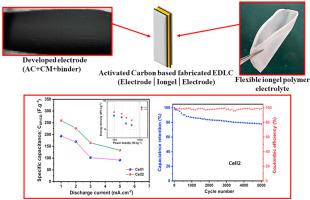Materials Today Sustainability ( IF 7.1 ) Pub Date : 2021-02-11 , DOI: 10.1016/j.mtsust.2021.100062 Alok Kumar Tripathi , Sevi Murugavel , Rajendra Kumar Singh

|
In this work, porous activated carbons (ACs) are synthesized from dead Ashoka leaves by a modified chemical activation method where KOH and K2CO3 are used as activating agent in different weight percentages. The irregular surface morphology, high surface area, and the substantial amount of micropores and mesopores volumes simultaneously have been found in the synthesized ACs. The surface morphology and porosity parameters of ACs have been found significant with changing the incorporated activating agents in the different weight percentages. These porous ACs derived from biowaste material have been tested as electrode material in the electric double-layer capacitors (EDLCs) with iongel polymer electrolyte (iPE). A series of iPEs have been prepared using PVdF-HFP polymer host, 1-ethyl-1-methylpyrrolidinium bis(trifluoromethylsulfonyl)imide ([PYR12][TFSI]) ionic liquid, and mixed organic carbonate-based plasticizers. EDLCs have been fabricated using AC-based electrodes and flexible iPE30 solid electrolyte. The high ionic conductivity (~6.11 × 10−3 S.cm−1 at 303 K), good electrochemical stability window (~ −2.74 V to +3.14 V vs. stainless steel electrodes), and flexible nature of the freestanding film of iPE30 provided outstanding compatibility with bio-derived AC electrodes. Cyclic voltammetry and galvanostatic charge–discharge studies have been performed, which show ideal and reversible capacitive features together with good cyclability of the fabricated EDLC cells.
中文翻译:

Dead Ashoka(Saraca asoca)叶片衍生的多孔活性炭和柔性离子凝胶聚合物电解质,用于高能量密度双电层电容器
在这项工作中,通过改良的化学活化方法,其中KOH和K 2 CO 3从死的阿育王叶中合成了多孔活性炭(AC)。以不同的重量百分比用作活化剂。在合成的AC中同时发现了不规则的表面形态,高的表面积以及大量的微孔和中孔体积。已经发现AC的表面形态和孔隙率参数对于以不同的重量百分比改变掺入的活化剂是重要的。这些源自生物废物材料的多孔AC已在带有离子凝胶聚合物电解质(iPE)的双电层电容器(EDLC)中作为电极材料进行了测试。使用PVdF-HFP聚合物主体1-乙基-1-甲基吡咯烷鎓双(三氟甲基磺酰基)酰亚胺([PYR 12] [TFSI])离子液体,以及混合的有机碳酸酯基增塑剂。EDLC是使用基于AC的电极和柔性iPE30固体电解质制成的。高离子电导率(303 K时 约为〜6.11 ×10 -3 S.cm -1),良好的电化学稳定性窗口(相对于不锈钢电极约为〜2.74 V至+3.14 V)以及iPE30独立膜的柔性与生物来源的交流电极具有出色的兼容性。已经进行了循环伏安法和恒电流充放电研究,这些研究表明理想的和可逆的电容特性以及所制造的EDLC电池的良好可循环性。











































 京公网安备 11010802027423号
京公网安备 11010802027423号